In the striking Milk: Kristen Hatgi Sink, now on view at Gildar Gallery, Sink sources milk as a multifarious metaphor in her photos, flooding the floor (actually a shallow pool) or pouring it over models. She explained to me that the digital enlargements, along with a video and an installation of shallow troughs of milk in the middle of the gallery, are meant to convey her own current circumstance of living in “the land of milk and honey,” the Bible’s promised land of abundance. That’s just the start of Sink’s meditations on the meaning of milk, however.
There’s also the color of milk: Together with the gallery’s white walls, it sets the tone for a show dominated by a brilliant whiteness. For Sink, white represents purity, lightness, innocence, maternity and more, but it also conjures up the evils of white supremacy and, by extension, the imperialistic exploitation of the non-white world. She acknowledges that white domination has helped create the land of milk and honey where she and so many people residing in advanced countries live. (Sink’s Honey, which addresses the other half of the analogy, opens at the Museum of Contemporary Art Denver on May 24.)
In “Bianca, Lamb, Citrus, Flowers, Milk,” a young girl with a peaches-and-cream complexion is seen sitting and holding a white lamb. On either side of her are citrus trees, just fruiting out, and across the ground, African violets in full bloom. The trees and the flowers have been removed from their pots and are partly submerged in milk that covers the ground; one of the girl’s feet is also in the milk. The photo is so carefully composed, so full of elements brimming with implied meanings, that it’s somewhat reminiscent of an iconographic religious painting. The cherubic quality of the girl and the dignified pose of the lamb are both well-established Christian icons, and the sky-blue ground enhances the impression that the photo is serving some sacred role. That religious content is intended by Sink, but it’s undercut by other meanings imbued in her pictures. Christianity, like the African violets, represents the unspoken dark side of colonialism: The West imposed Christianity on colonized peoples while taking away their wealth, signified by the violets. The flowers and the fruit trees will die as their exposed roots soak up milk instead of water, providing a subtle critique of imperialism that drafts the girl and her lamb into the sorry story.
Sink’s references to religious paintings are even more pronounced in photos such as “Rianna, Narcissus, Veil, Milk” and “Meredith, Lilies, Milk.” In each, milk has been poured over the head of a young woman as well as over the flowers that she is holding; both pieces look like depictions of the Madonna. As we walked through the show with Sink, gallery director Adam Gildar noted that someone had said her work was reminiscent of that of Giotto, the Italian master. I didn’t see it at first, until I noticed all that luscious Giotto blue. Combined with the religious symbolism, it gives the show an Italianate aura.
At Rule Gallery, Jason DeMarte: Adorned also riffs on art history. In his artist’s statement, DeMarte cites the landscape painters of the Hudson River School — but classic Dutch floral still-life scenes are what came to my mind. DeMarte has also written about how important certain early photographers were to him, and that’s easier to see. DeMarte name-checks Oscar Gustave Rejlander and Julia Margaret Cameron, photographers he calls “pioneers in manipulating truth in the medium” instead of objectively recording external reality with a camera.
Rejlander and Cameron were both interested in creating fictional realities in photos and pioneered the analogue ancestor of Photoshop. They did so by cutting up negatives from photos they took, then assembling the fragments to create a single image that was ultimately printed as a photograph.
DeMarte does much the same thing but uses the now-tried-and-true Photoshop in its digital form, putting the elements together on the screen, then having prints made of the results. In “Fog of Tranquility,” DeMarte has inserted, tweaked and manipulated dozens of individual elements over a hundred times. The piece depicts a garden filled with blooming and budding flowers, with several birds perched on stems in and among them; the entire scene is set against a threatening sky. The shots of flowers are taken in various places, including gardens in the artist’s back yard; the images of the birds were produced using remote cameras tripped when a bird landed on DeMarte’s birdfeeder. Adding a surreal note, the flowers have been drizzled with some kind of translucent colored liquid that pools or organizes into droplets, depending on where they’ve wound up — though the nectar is just an illusion of the process standing in for physics. Pushing the artifice even further is “After the Deluge,” which also employs depictions of flowers along with a single bird. Here the flowers and bird are coated in what looks like pink latex paint, with the plants bending under the weight.

"Invasive Apathy" (L) and "Unseasonable Icing" (R), by Jason DeMarte, archival pigment print.
Courtesy of the artist
Since nothing actually connects Sink and DeMarte as individuals or as artists, it’s interesting that they’ve independently come up with such remarkably similar concepts. Not only do the same aesthetic intentions underlie the work, but the two photographers display a shared interest in flowers and liquid. In fact, there’s such a convergence of ideas between the two that these solos a couple of miles apart function as an ad hoc duet.
Milk: Kristen Hatgi Sink, through June 17 at Gildar Gallery, 82 South Broadway, 303-993-4474, gildargallery.com.
Jason DeMarte: Adorned, through June 16, Rule Gallery, 530 Santa Fe Drive, 303-800-6776, rulegallery.com.














